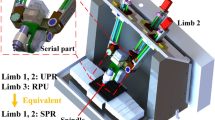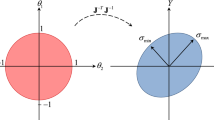Abstract
Based on the complete differential-coefficient theory, the model of the pose errors expressed by the Rodrigues Parameters was established. By normalizing all error sources, the statistical model of sensitivity coefficients was obtained. Considering the sensitivity percentages, a kinematic calibration model with the successive approximation algorithm was achieved. The simulation shows that the algorithm is effective to study the calibration question and has concrete directivity, reducing the kinematic errors with high sensitivity percentage when optimizing iteratively.
Similar content being viewed by others
References
T. Huang, X. Y. Zhao and D. J. Whitehouse, Stiffness estimation of a tripod-based parallel kinematic machine, IEEE Transactions on Robotics and Automation, 18(1) (2002) 50–58.
X. Q. Tang, J. S. Wang, H. Zhang, et al, On the analysis of active reflector supporting manipulator for the large spherical radio telescope, Mechatronics, 14 (2004) 1037–1053.
Y. M. Li and Q. S. Xu, Kinematic analysis of a 3-PRS parallel manipulator, Robotics and Computer-integrated Manufacturing, 23(4) (2007) 395–408.
G. Cheng, S. R. Ge and Y. Wang, Error analysis of three degree-of-freedom changeable parallel measuring mechanism, Journal of China University of Mining & Technology, 17(1) (2007) 101–104.
Z. Meng, R. S. Che, Q. C. Huang et al., The direct-errorcompensation method of measuring the error of a six-freedom-degree parallel mechanism CMM, Journal of Materials Processing Technology, 129 (2002) 574–578.
T. Huang, Y. Li, G. B. Tang et al., Error modeling, sensitivity analysis and assembly process of a class of 3-DOF parallel kinematic machines with parallelogram struts, Science in China: Series E, 45(5) (2002) 467–476.
M. Hassan and L. Notash, Design Modification of Parallel Manipulators for Optimum Fault Tolerance to Joint Jam, Mechanism and Machine Theory, 40 (2005) 559–577.
A. Pott, A. Kecskeméthy and M. Hiller, A simplified force-based method for the linearization and sensitivity analysis of complex manipulation systems, Mechanism and Machine Theory, 42 (2007) 1445–1461.
G. Alici and B. Shirinzadeh, Optimum dynamic balancing of planar parallel manipulators based on sensitivity analysis, Mechanism and Machine Theory, 41 (2006) 1520–1532.
P. Renaud, N. Andreff and J. M. Lavest et al., Simplifying the kinematic calibration of parallel mechanisms using vision-based metrology, IEEE Transactions on Robotics, 22(1) (2006) 12–22.
S. Besnard and W. Khalil, Calibration of parallel robots using two inclinometers, IEEE International Conference of Robotics and Automation, Detroit, Michigan (1999) 1758–1763.
H. Zhuang, O. Masory and J. Yan, Kinematic calibration of a stewart platform using pose measurement obtained by a single theodolite, IEEE International Conference on Intelligent Robots and Systems (1995) 329–334.
Y. Koseki, T. Arai, K. Sugimoto et al., Design and accuracy evaluation of high-speed and high precision parallel mechanism, IEEE International Conference on Robotics & Automation, Leuven, Belgium (1998) 1340–1345.
Y. Chiu and M. Perng, Self-calibration of a general hexapod manipulator with enhanced precision in 5-DOF motions, Mechanism and Machine Theory, 39 (2004) 1–23.
Y. hang, S. Cong, Z. Li et al., Auto-calibration of a redundant parallel manipulator based on the projected tracking error, Archive of Applied Mechanics, 77 (2007) 697–706.
J. Jeong, S. Kim and Y. Kwak, Kinematics and workspace analysis of a parallel wire mechanism for measuring a robot pose, Mechanism and Machine Theory, 34 (1999) 825–841.
Y. J. Chiu and M. H. Perng, Self-calibration of a general hexapod manipulator using cylinder constraints, International Journal of Machine tools & Manufacture, 43 (2003) 1051–1066.
P. Last and J. Hesselbach, A new calibration strategy for a class of parallel mechanisms, Advances in Robot Kinematics (2006) 331–338.
O. Rodirgues, Des lois géométriques qui régissent les déplacements d’un systéme solide dans l’espace, et de la variation des coordonnées provenant de ces déplacements considérés indépendamment des causes qui peuvent les produire, Journal de Mathématiques, 5 (1840) 380–440.
J. Dai, An historical review of the theoretical development of rigid body displacements from Rodrigues parameters to the finite twist, Mechanism and Machine Theory, 41 (2006) 41–52.
A. Cayley, On three-bar motion, Proceedings of the London Mathematical Society V, II (1875) 136–166.
G. Cheng, S. Ge and S. Jiang, Research on transient kinematic characteristics of 3-UCR parallel robot, Optics and Precision Engineering, 16 (2008) 108–113.
Author information
Authors and Affiliations
Corresponding author
Additional information
This paper was recommended for publication in revised form by Editor Yeon June Kang
Gang Cheng received the M.S. degree in 2003 from the Chinese Academy of Sciences and the Dr. Sc. Tech degree in 2008 from China University of Mining and Technology. Currently, he is an associate professor of China University of Mining and Technology in China. His research interests include mechanism theory and reliability of electromechanical equipment.
Shi-Rong Ge graduated in 1983 from Heilongjiang Mining Institute and received the Dr. Sc. Tech degree in 1989 from China University of Mining and Technology. Currently, he is a professor of China University of Mining and Technology. His research interests include non-linearity of tribology, rescue robot and mining machinery reliability.
Jing-Li Yu is currently a postgraduate student at the College of Mechanical and Electrical Engineering of China University of Mining and Technology in China. Her research interest is mechanism theory.
Rights and permissions
About this article
Cite this article
Cheng, G., Ge, SR. & Yu, JL. Sensitivity analysis and kinematic calibration of 3-UCR symmetrical parallel robot leg. J Mech Sci Technol 25, 1647–1655 (2011). https://doi.org/10.1007/s12206-011-0417-9
Received:
Revised:
Accepted:
Published:
Issue Date:
DOI: https://doi.org/10.1007/s12206-011-0417-9




